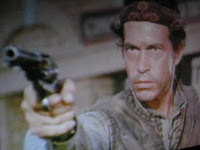 Jean-Luc Godard's Les Carabiniers (1963) is an allegorical journey of two brothers in an unspecified country who are enlisted in the unspecified King's army to fight all the King's enemies until the King has finally won the war. Marino Mase and Albert Juross star as Ulysses and Michel-Ange, rural peasants who
Jean-Luc Godard's Les Carabiniers (1963) is an allegorical journey of two brothers in an unspecified country who are enlisted in the unspecified King's army to fight all the King's enemies until the King has finally won the war. Marino Mase and Albert Juross star as Ulysses and Michel-Ange, rural peasants who live in a wooden shack without electricity or indoor plumbing, along with their girlfriends Cleopatra (Catherine Ribeiro) and Venus (Genevieve Galea). Godard co-wrote the original script with Roberto Rossellini and the film makes obvious cross-allusions to the beginnings of WWII, albeit translated to the modern-day 1960s. Two of the King's soldiers visit the quartet on their bleak farm and offer not only all the
live in a wooden shack without electricity or indoor plumbing, along with their girlfriends Cleopatra (Catherine Ribeiro) and Venus (Genevieve Galea). Godard co-wrote the original script with Roberto Rossellini and the film makes obvious cross-allusions to the beginnings of WWII, albeit translated to the modern-day 1960s. Two of the King's soldiers visit the quartet on their bleak farm and offer not only all the  riches and marvels of the world (taken at their enemies expense) but all of its atrocities as well (rape, arson, execution). Filmed in a desolate b/w and intermixed with newsreel footage and war-torn urban locations, the camera accompanies Ulysses and Michel-Ange on their Odyssey across the European and North African countryside as they transform into willing and eager carabiniers, executing the blond Leninist spokeswoman of the 4th Territorial Action Group who compares Bourgeoisie Capitalists to
riches and marvels of the world (taken at their enemies expense) but all of its atrocities as well (rape, arson, execution). Filmed in a desolate b/w and intermixed with newsreel footage and war-torn urban locations, the camera accompanies Ulysses and Michel-Ange on their Odyssey across the European and North African countryside as they transform into willing and eager carabiniers, executing the blond Leninist spokeswoman of the 4th Territorial Action Group who compares Bourgeoisie Capitalists to  evil insects, yet faithfully writing letters home to Venus and Cleopatra from every stop along the way. Upon their return, they indeed have all the world's riches and marvels with them. Though Godard's work, at times, seems to betray a need to insulate himself from criticism by intertwining style and message (if you fault one he blames the other), Les Carabiniers is a tragic-comedic homage to the theater of the absurd; its deadpan style (and title cards) reminiscent of Chaplin at his best--The Great Dictator being an obvious starting point. The film also
evil insects, yet faithfully writing letters home to Venus and Cleopatra from every stop along the way. Upon their return, they indeed have all the world's riches and marvels with them. Though Godard's work, at times, seems to betray a need to insulate himself from criticism by intertwining style and message (if you fault one he blames the other), Les Carabiniers is a tragic-comedic homage to the theater of the absurd; its deadpan style (and title cards) reminiscent of Chaplin at his best--The Great Dictator being an obvious starting point. The film also  manages to employ many of Godard's usual motifs: movie theaters, bathtubs, American cars, cigarettes, revolutionary politics, advertisements, guns. Upon its release, Louis Chauvet wrote in Le Figaro on June 5, 1963 that it offered only "childish paradoxes of war" and Michel Cournot, writing in L'Express on June 13, 1963, said that its unbearable ignominy was a disaster to French filmmaking and that it should be shown in an empty lot with a sheet on the wall and viewers sitting on empty milk crates instead of in a nice theater with velvet seats (Cournot did not realize that he was way ahead of his time). Les Carabiniers remains a kind of forgotten film of the French New Wave, though it deserves a place alongside Band of Outsiders (1964) as Godard's finest work. Watch for Barbet Schroeder (Maitresse, Barfly) in a small role as a car saleman.
manages to employ many of Godard's usual motifs: movie theaters, bathtubs, American cars, cigarettes, revolutionary politics, advertisements, guns. Upon its release, Louis Chauvet wrote in Le Figaro on June 5, 1963 that it offered only "childish paradoxes of war" and Michel Cournot, writing in L'Express on June 13, 1963, said that its unbearable ignominy was a disaster to French filmmaking and that it should be shown in an empty lot with a sheet on the wall and viewers sitting on empty milk crates instead of in a nice theater with velvet seats (Cournot did not realize that he was way ahead of his time). Les Carabiniers remains a kind of forgotten film of the French New Wave, though it deserves a place alongside Band of Outsiders (1964) as Godard's finest work. Watch for Barbet Schroeder (Maitresse, Barfly) in a small role as a car saleman.






































